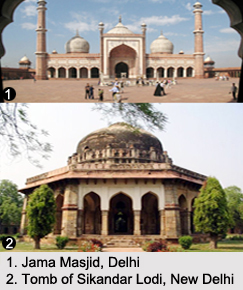 The National Capital Territory of Delhi has been the cradle of many chronologies and events through Indian History. Most notable for having been the capital of the mighty Mughal Empire, Delhi"s monuments are standing embodiments of the architectural splendour prevalent in the Mughal era.
The National Capital Territory of Delhi has been the cradle of many chronologies and events through Indian History. Most notable for having been the capital of the mighty Mughal Empire, Delhi"s monuments are standing embodiments of the architectural splendour prevalent in the Mughal era.
Red Fort, Delhi
Red Fort is a prime historical monument of India, a standing embodiment of architectural finesse during the reign of Mughal emperor Shah Jahan. The fort was constructed when Shah Jahan, in 1639, shifted the capital of the empire from Agra to Delhi to elevate his regime"s esteem and fulfill his motivated building plans. It took 9 years to complete in 1648 and served as the residence of the Mughal emperor till Bahadur Shah Zafar"s regime. The majestic fort houses a number of imposing palaces and museums, like the Diwan-i-Aam, Diwan-i-Khaas, Nahr-i-Behisht, Mumtaz Mahal and others, all of which served specific purposes for Mughal rulers, their wives and mistresses.
Humayun"s Tomb, Delhi
Humayun"s Tomb is another UNESCO-recognized architectural marvel of the Mughal Dynasty, one of the earliest structures and the first erected on a grand scale in red sandstone. It was commissioned by Emperor Akbar in 1569-70 and designed under the supervision of Humayun"s chief consort Bega Begum.
Jama Masjid, Delhi
 The Jama Masjid in Delhi, built by Emperor Shah Jahan between 1644 and 1656, is one of the largest mosques in India. It encompasses 3 large gates, 4 towers, two 40-metre high minarets constructed of strips of red sandstone and white marble and the courtyard that can accommodate more than 25,000 people. The mosque has been the site of political and religious strife, with two attacks in 2006 and 2010.
The Jama Masjid in Delhi, built by Emperor Shah Jahan between 1644 and 1656, is one of the largest mosques in India. It encompasses 3 large gates, 4 towers, two 40-metre high minarets constructed of strips of red sandstone and white marble and the courtyard that can accommodate more than 25,000 people. The mosque has been the site of political and religious strife, with two attacks in 2006 and 2010.
Qutub Minar, Delhi
Qutub Minar located in Mehrauli area in Delhi is the second highest minar in India standing at 73 metres. Inside the tower, a circular staircase with 379 steps heads to the top. Made of red sandstone and marble, its exterior has bricks covered with intricate iron carvings and verses from the holy Quran.
Lodi Tombs, Delhi
The tombs of rulers of the Lodi Dynasty are situated in the scenic beauty of Lodi Gardens in New Delhi. These include Mohammed Shah`s Tomb, Tomb of Sikandar Lodi, Shisha Gumbad and Bara Gumbad, architectural works of 15th century by the Lodis who had ruled parts of northern India and Punjab from 1451 to 1526.
India Gate, a memorial to 82,000 soldiers of the undivided Indian Army who were martyred in the period 1914-21 during World War I and Safdarjung`s Tomb, a sandstone and marble mausoleum built for Mughal statesman Safdarjung, who was made prime minister of the Mughal Empire under Ahmad Shah Bahadur"s regime, are other notable historical monuments in Delhi.



















